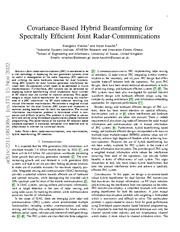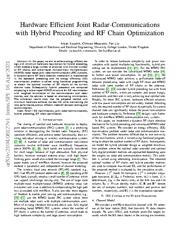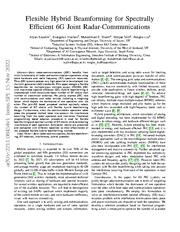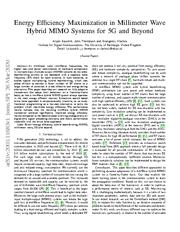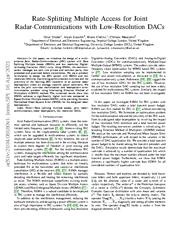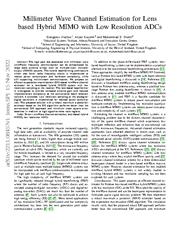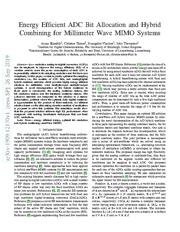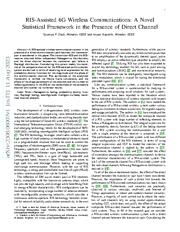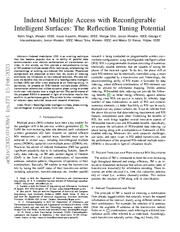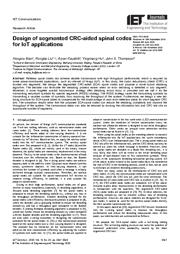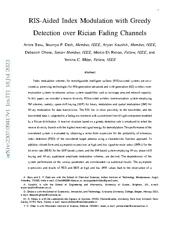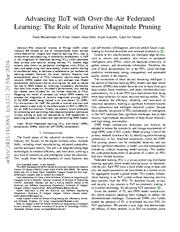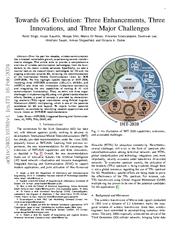A copy of this work was available on the public web and has been preserved in the Wayback Machine. The capture dates from 2022; you can also visit the original URL.
The file type is application/pdf.
Filters
Covariance-Based Hybrid Beamforming for Spectrally Efficient Joint Radar-Communications
[article]
2022
arXiv
pre-print
Joint radar-communications (JRC) is considered to be a vital technology in deploying the next generation systems, since its useful in decongestion of the radio frequency (RF) spectrum and utilising the same hardware resources for dual functions. Using JRC systems for dual function generates interference between both the operations which needs to be addressed in future standardization. Furthermore, JRC systems can be advanced by deploying hybrid beamforming which implements fewer number of RF
arXiv:2211.08308v1
fatcat:r6dtzgprbbaqnnvj3eurarvvme
more »
... ins than the number of transmit antennas. This paper designs a robust hybrid beamformer for minimizing the interference of a JRC transmitter via RF chain selection resulting into mutual information maximization. We consider a weighted mutual information for the dual function JRC system and implement a common analog beamformer for both the operations. The mutual information maximization problem is formulated which is non-convex and difficult to solve. The problem is simplified to convex form and solved using Dinkelbach approximation abased fractional programming. The performance of the optimal RF selection based proposed approach is evaluated, compared with baselines and its effectiveness is inferred via numerical results.
Hierarchical Multi-Agent Optimization for Resource Allocation in Cloud Computing
[article]
2020
arXiv
pre-print
In cloud computing, an important concern is to allocate the available resources of service nodes to the requested tasks on demand and to make the objective function optimum, i.e., maximizing resource utilization, payoffs and available bandwidth. This paper proposes a hierarchical multi-agent optimization (HMAO) algorithm in order to maximize the resource utilization and make the bandwidth cost minimum for cloud computing. The proposed HMAO algorithm is a combination of the genetic algorithm
arXiv:2001.03929v1
fatcat:n4dnk4f5yfexrmd2ffg7oklldm
more »
... and the multi-agent optimization (MAO) algorithm. With maximizing the resource utilization, an improved GA is implemented to find a set of service nodes that are used to deploy the requested tasks. A decentralized-based MAO algorithm is presented to minimize the bandwidth cost. We study the effect of key parameters of the HMAO algorithm by the Taguchi method and evaluate the performance results. When compared with genetic algorithm (GA) and fast elitist non-dominated sorting genetic (NSGA-II) algorithm, the simulation results demonstrate that the HMAO algorithm is more effective than the existing solutions to solve the problem of resource allocation with a large number of the requested tasks. Furthermore, we provide the performance comparison of the HMAO algorithm with the first-fit greedy approach in on-line resource allocation.
Reconfigurable Intelligent Surfaces Assisted Communication Under Different CSI Assumptions
[article]
2023
arXiv
pre-print
This work studies the net sum-rate performance of a distributed reconfigurable intelligent surfaces (RISs)-assisted multi-user multiple-input-single-output (MISO) downlink communication system under imperfect instantaneous-channel state information (I-CSI) to implement precoding at the base station (BS) and statistical-CSI (S-CSI) to design the RISs phase-shifts. Two channel estimation (CE) protocols are considered for I-CSI acquisition: (i) a full CE protocol that estimates all direct and
arXiv:2308.04619v1
fatcat:y66za4qaefbnvgtkmjafo77i4y
more »
... assisted channels over multiple training sub-phases, and (ii) a low-overhead direct estimation (DE) protocol that estimates the end-to-end channel in a single sub-phase. We derive the asymptotic equivalents of signal-to-interference-plus-noise ratio (SINR) and ergodic net sum-rate under both protocols for given RISs phase-shifts, which are then optimized based on S-CSI. Simulation results reveal that the low-complexity DE protocol yields better net sum-rate than the full CE protocol when used to obtain CSI for precoding. A benchmark full I-CSI based RISs design is also outlined and shown to yield higher SINR but lower net sum-rate than the S-CSI based RISs design.
Hardware Efficient Joint Radar-Communications with Hybrid Precoding and RF Chain Optimization
[article]
2021
arXiv
pre-print
In this paper, we aim to achieve energy efficient design with minimum hardware requirement for hybrid precoding, which enables a large number of antennas with minimal number of RF chains, and sub-arrayed multiple-input multiple-output (MIMO) radar based joint radar-communication (JRC) systems. A dynamic active RF chain selection mechanism is implemented in the baseband processing and the energy efficiency (EE) maximization problem is solved using fractional programming to obtain the optimal
arXiv:2104.08127v1
fatcat:foefjhxjnjbglai2abh57y3y5a
more »
... er of RF chains at the current channel state. Subsequently hybrid precoders are computed employing a sub-arrayed MIMO structure for EE maximization with weighted formulation of the communication and radar metrics, and the solution is based on alternating minimization. The simulation results show that the proposed method with minimum hardware achieves the best EE while maintaining the rate performance, and an efficient trade-off between sensing and communication.
Flexible Hybrid Beamforming for Spectrally Efficient 6G Joint Radar-Communications
[article]
2022
arXiv
pre-print
Joint radar-communications (JRC) benefits from multi-functionality of radar and communication operations using same hardware and radio frequency (RF) spectrum resources. Thus JRC systems possess very high potential to be employed into the sixth generation (6G) standards. This paper designs a flexible beamformer for multiple-input multiple output (MIMO) JRC with maximized spectral efficiency (SE). Hybrid beamforming is implemented which constitutes lesser number of RF chains than number of
arXiv:2211.08454v1
fatcat:dyqgbxsrpja5nkbt6soshyzeoq
more »
... itter antennas. We jointly express JRC rate with communication and radar entities including a weighting factor which depicts the dominance of one operation over the other. The joint-SE based proposed method optimally selects the number of RF chains with flexible hynrid beamforming design. Furthermore, when the communication operation takes place the proposed method takes into account the interference occurring from the radar operation and vice-versa. Fractional programming based selection procedure is used for flexible beamforming and optimal number of RF chains while considering interference of each operation. Simulation results are presented and compared with different baselines to show effectiveness of the proposed flexible hybrid beamforming method.
Energy Efficiency Maximization in Millimeter Wave Hybrid MIMO Systems for 5G and Beyond
[article]
2020
arXiv
pre-print
At millimeter wave (mmWave) frequencies, the higher cost and power consumption of hardware components in multiple-input multiple output (MIMO) systems do not allow beamforming entirely at the baseband with a separate radio frequency (RF) chain for each antenna. In such scenarios, to enable spatial multiplexing, hybrid beamforming, which uses phase shifters to connect a fewer number of RF chains to a large number of antennas is a cost effective and energy-saving alternative. This paper describes
arXiv:2003.11683v1
fatcat:ofqr7ktc6zbrfj44dkbhtxu564
more »
... our research on fully adaptive transceivers that adapt their behaviour on a frame-by-frame basis, so that a mmWave hybrid MIMO system always operates in the most energy efficient manner. Exhaustive search based brute force approach is computationally intensive, so we study fractional programming as a low-cost alternative to solve the problem which maximizes energy efficiency. The performance results indicate that the resulting mmWave hybrid MIMO transceiver achieves significantly improved energy efficiency results compared to the baseline cases involving analogue-only or digital-only signal processing solutions, and shows performance trade-offs with the brute force approach.
Rate-Splitting Multiple Access for Joint Radar-Communications with Low-Resolution DACs
[article]
2021
arXiv
pre-print
In this paper, we introduce the design of a multi-antenna Joint Radar-Communication (JRC) system with Rate Splitting Multiple Access (RSMA) and low resolution Digital-to-Analog Converter (DAC) units. Using RSMA, the communication messages are split into private and common parts, then precoded and quantized before transmission. We use a problem formulation to design the JRC system with RSMA and low resolution DACs by maximizing communication sum-rate and the proximity of the resulting JRC
arXiv:2104.08180v1
fatcat:26rjumnslbbmhbn5cwqdn3qh54
more »
... m to an optimal radar beampattern under an average transmit power constraint. We solve the joint sum-rate maximization and beampattern error minimization problem using Alternating Direction Method of Multipliers (ADMM) method. The numerical results show that RSMA achieves a significantly higher sum-rate compared to Space Division Multiple Access (SDMA) while providing the same Normalized Mean Square Error (NMSE) for the designed radar beampattern.
Millimeter Wave Channel Estimation for Lens based Hybrid MIMO with Low Resolution ADCs
[article]
2022
arXiv
pre-print
The high path loss associated with millimeter wave (mmWave) frequency communication can be compensated by large scale antenna arrays such as multiple-input multiple-output (MIMO) systems. The hybrid beamforming architecture which uses fewer radio frequency chains is implemented to reduce power consumption and hardware complexity, while still supporting multi-stream communication. We propose an efficient expectation-maximization (EM)-based mmWave channel estimator for a lens-based hybrid MIMO
arXiv:2211.08457v1
fatcat:fmnnhjjoivh7ld7uyoqeefujbq
more »
... tem with low resolution sampling at the receiver. The lens-based beamformer is investigated to provide increased antenna gain and reduced implementation complexity as the conventional beam selection network is excluded. Low resolution sampling at the analog-to-digital converters is implemented for reduced power consumption. The proposed solution with a robust maximum a posteriori estimator based on the EM algorithm performs better than the conventional EM approach and minimum mean square error baselines in medium to high signal-to-noise ratio regions.
Energy Efficient ADC Bit Allocation and Hybrid Combining for Millimeter Wave MIMO Systems
[article]
2019
arXiv
pre-print
Low resolution analog-to-digital converters (ADCs) can be employed to improve the energy efficiency (EE) of a wireless receiver since the power consumption of each ADC is exponentially related to its sampling resolution and the hardware complexity. In this paper, we aim to jointly optimize the sampling resolution, i.e., the number of ADC bits, and analog/digital hybrid combiner matrices which provides highly energy efficient solutions for millimeter wave multiple-input multiple output systems.
arXiv:1909.12170v1
fatcat:6piexor6wfhrdb2wo6l6w7o4jm
more »
... novel decomposition of the hybrid combiner to three parts is introduced: the analog combiner matrix, the bit resolution matrix and the baseband combiner matrix. The unknown matrices are computed as the solution to a matrix factorization problem where the optimal, fully digital combiner is approximated by the product of these matrices. An efficient solution based on the alternating direction method of multipliers is proposed to solve this problem. The simulation results show that the proposed solution achieves high EE performance when compared with existing benchmark techniques that use fixed ADC resolutions.
RIS-Assisted 6G Wireless Communications: A Novel Statistical Framework in the Presence of Direct Channel
[article]
2023
arXiv
pre-print
Kaushik is with the School of Engineering and Informatics, University of Sussex, Brighton, UK, e-mail: aryan.kaushik@sussex.ac.uk. generation of wireless standards. ...
arXiv:2308.06007v1
fatcat:k4o2vlylarcctg5hpxhessnlkq
Indexed Multiple Access with Reconfigurable Intelligent Surfaces: The Reflection Tuning Potential
[article]
2023
arXiv
pre-print
Indexed modulation (IM) is an evolving technique that has become popular due to its ability of parallel data communication over distinct combinations of transmission entities. In this article, we first provide a comprehensive survey of IM-enabled multiple access (MA) techniques, emphasizing the shortcomings of existing non-indexed MA schemes. Theoretical comparisons are presented to show how the notion of indexing eliminates the limitations of non-indexed solutions. We also discuss the benefits
arXiv:2302.07476v1
fatcat:q2f3udmsy5bmvbp57bzspepcmi
more »
... that the utilization of a reconfigurable intelligent surface (RIS) can offer when deployed as an indexing entity. In particular, we propose an RIS-indexed multiple access (RIMA) transmission scheme that utilizes dynamic phase tuning to embed multi-user information over a single carrier. The performance of the proposed RIMA is assessed in light of simulation results that confirm its performance gains. The article further includes a list of relevant open technical issues and research directions.
Design of segmented CRC-aided spinal codes for IoT applications
2020
IET Communications
Rateless spinal codes can achieve reliable transmission with high throughput performance, which is required by some power-constrained applications, such as internet of things (IoT). In this study, the cyclic redundancy check (CRC) is divided into segments. We design the segmented CRC-aided (SCA) spinal codes and propose a novel hybrid decoding algorithm. The decoder can terminate the decoding process earlier when an error decoding is detected in any segment. Moreover, a more targeted symbol
doi:10.1049/iet-com.2019.0907
fatcat:zarxqaaxljbtlekc5m3lpddl3y
more »
... smission strategy after decoding errors occur is provided and we call it as the transmitting redundant symbols for specific segments (RSSS) strategy. The RSSS strategy saves the transmitting symbols by transmitting a variable number of symbols, thus improving the throughput of the system. Furthermore, we design a new tailbiting structure for SCA-spinal codes to compensate for the disadvantage of poor error detection ability for short segment CRC bits. The simulation results show that the proposed SCA-spinal codes can reduce the decoding complexity and improve the throughput of the system. The transmission delay can also be reduced by dividing the information bits and CRC bits into an appropriate number of segments. • We propose the SCA-spinal codes with a tail-biting coding structure. The tail-biting coding structure can solve the problem of increased undetected error probability caused by the short segmented CRC bits. Fig. 16 Total transmission delay comparison between the spinal codes and the SCA-spinal codes 3548
RIS-Aided Index Modulation with Greedy Detection over Rician Fading Channels
[article]
2023
arXiv
pre-print
Index modulation schemes for reconfigurable intelligent surfaces (RIS)-assisted systems are envisioned as promising technologies for fifth-generation-advanced and sixth-generation (6G) wireless communication systems to enhance various system capabilities such as coverage area and network capacity. In this paper, we consider a receive diversity RIS-assisted wireless communication system employing IM schemes, namely, space-shift keying (SSK) for binary modulation and spatial modulation (SM) for
arXiv:2307.09417v1
fatcat:5kdocs2b7zbrbolehw5l4ypr2q
more »
... ary modulation for data transmission. The RIS lies in close proximity to the transmitter, and the transmitted data is subjected to a fading environment with a prominent line-of-sight component modeled by a Rician distribution. A receiver structure based on a greedy detection rule is employed to select the receive diversity branch with the highest received signal energy for demodulation. The performance of the considered system is evaluated by obtaining a series-form expression for the probability of erroneous index detection (PED) of the considered target antenna using a characteristic function approach. In addition, closed-form and asymptotic expressions at high and low signal-to-noise ratios (SNRs) for the bit error rate (BER) for the SSK-based system, and the SM-based system employing M-ary phase-shift keying and M-ary quadrature amplitude modulation schemes, are derived. The dependencies of the system performance on the various parameters are corroborated via numerical results. The asymptotic expressions and results of PED and BER at high and low SNR values lead to the observation of a performance saturation and the presence of an SNR value as a point of inflection, which is attributed to the greedy detector's structure.
Advancing IIoT with Over-the-Air Federated Learning: The Role of Iterative Magnitude Pruning
[article]
2024
arXiv
pre-print
The industrial Internet of Things (IIoT) under Industry 4.0 heralds an era of interconnected smart devices where data-driven insights and machine learning (ML) fuse to revolutionize manufacturing. A noteworthy development in IIoT is the integration of federated learning (FL), which addresses data privacy and security among devices. FL enables edge sensors, also known as peripheral intelligence units (PIUs) to learn and adapt using their data locally, without explicit sharing of confidential
arXiv:2403.14120v1
fatcat:qfpmark2uvf3zojda6urlck7ca
more »
... , to facilitate a collaborative yet confidential learning process. However, the lower memory footprint and computational power of PIUs inherently require deep neural network (DNN) models that have a very compact size. Model compression techniques such as pruning can be used to reduce the size of DNN models by removing unnecessary connections that have little impact on the model's performance, thus making the models more suitable for the limited resources of PIUs. Targeting the notion of compact yet robust DNN models, we propose the integration of iterative magnitude pruning (IMP) of the DNN model being trained in an over-the-air FL (OTA-FL) environment for IIoT. We provide a tutorial overview and also present a case study of the effectiveness of IMP in OTA-FL for an IIoT environment. Finally, we present future directions for enhancing and optimizing these deep compression techniques further, aiming to push the boundaries of IIoT capabilities in acquiring compact yet robust and high-performing DNN models.
Towards 6G Evolution: Three Enhancements, Three Innovations, and Three Major Challenges
[article]
2024
arXiv
pre-print
Kaushik is with the School of Engineering & Informatics, University of Sussex, UK (e-mail: aryan.kaushik@sussex.ac.uk). W. ...
arXiv:2402.10781v1
fatcat:7p34ff6645dw7ibmti6ag374oa
« Previous
Showing results 1 — 15 out of 129 results

